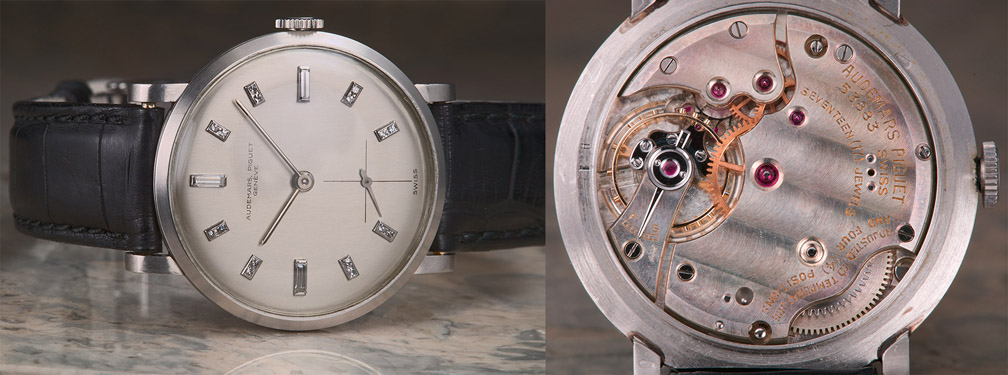

The present watch is from 1948, and the design and mechanicals notably reflect that earlier era, one which considered diamond hour markers to be elegant, and thin cases to be beautiful. On the inside, today it is expected that a great watch house will also be a strict manufacture with its own line of unique movements, but it was not always so. Until the cheap availability of ultra-accurate quartz watches helped make mechanical timekeeping far more art than science, even the finest watchmakers regularly began with an ebauche, adding or altering parts as needed, and of course providing finish and adjustment to their own aesthetic and performance standards. A movement was judged according to the quality of the finished product more than its conception, and the fragmented and specialized nature of the Swiss watch industry was understood and appreciated
When manufactured some sixty years ago, this would have been a very expensive and dressy, high-performance watch. It is 37mm diameter (exclusive of crown), but ultra-thin at 6mm (7.5 with crystal). The platinum case is entirely brushed (as is the dial), presenting a very low-key stage for the brilliant diamond hour markers and their polished settings. While diamonds on a contemporary watch are generally seen as ostentatious, this watch is wholly monochrome and quite subdued, and the effect is very subtle and elegant.
Click the pictures for even larger!
The cardinal hours are marked by rectangular diamonds set with crimps, while the remainder are each a pair of rounds surrounded by a stepped frame. At normal viewing distance, the markers are simply broadly reflective, with occasional bright highlights.
Rectangular when seen from above, the lugs curve downwards a full ninety degrees to hug the wrist and accentuate the thin profile:
This view of the case shows an elaborate mix of straight and concentric brushing:
(I offer special thanks to Suitbert Walter for his extraordinary assisitance in identifying and explaining the history of the 13 ligne Valjoux movements)
Despite its very formal design, this watch has been fitted with an exceptionally large and robust movement. The Valjoux VZ series is 13 lignes (about 29.5mm diameter), and has been around since at least the 1920s. Records indicate that Audemars Piguet used this ebauche (sparingly) into the 1980s, but it still shows up in some contemporary wristwatches:
Apparently reliable, flexible and strong, the VZ was primarily the base for chronographs and complicated calendar watches, including the very top tier:
Of particular interest is its use in observatory chronometers, where these same attributes are highly valued:
A study of the production tables included in Gisbert Brunner's 125 Years of Audemars Piguet suggests that during the six-plus decades from the 1920s, AP used perhaps 2000 Valjoux VZ ebauches, primarily in chronographs and world-timers, but occasionally in simple, time-only watches. Clearly this is a special watch, running an unusual and highly-regarded movement, one capable of providing superior timekeeping, and fully appropriate to its beautiful and expensive surroundings.
The shape of this opening between the bridges is the signature of these movements. The details are worth a closer look:
The balance with blued overcoil hairspring, supremely polished pallet bridge, one end of the anchor with its jewel:
Close-up crop from above, incredible metalwork!
Anglaged edge of the little bridge for the fourth and escape wheels, polished countersinks for the jewels. Please note at the picture's lower left the section of the screwed balance and its reflection in the pallet bridge -- a wonderful example of "black polished" steel!
The regulator, perfect polished sculpture:
Barrel wheel with polished teeth, amazing patina-ed Geneve waves!
Please check out the rest of my watch Articles and pics:
I hope you enjoyed this!
SteveG
July 25, 2007